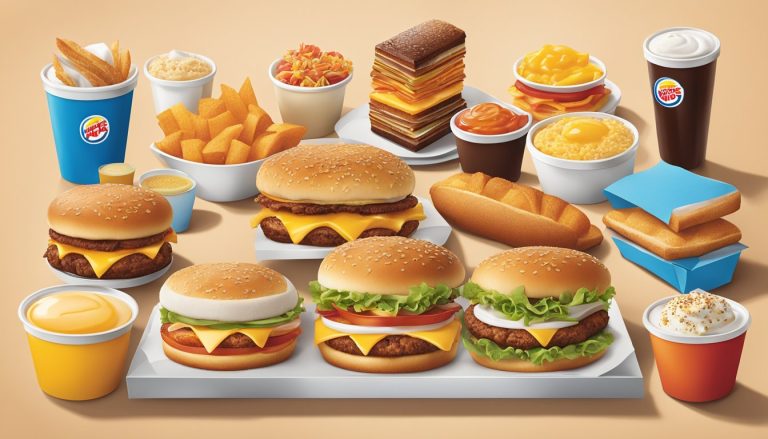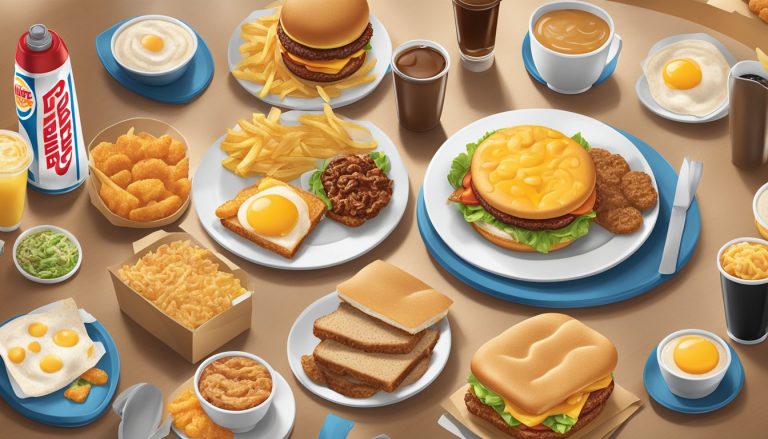Burger King’s breakfast menu has become a significant part of American morning culture since its introduction in the 1970s. The fast-food giant’s foray into the breakfast market has shaped how many Americans start their day, offering quick and convenient options for those on the go. BK’s breakfast items, particularly the Croissan’wich, have influenced breakfast trends and consumer expectations across the country.
The BK Café concept further expanded Burger King’s impact on American mornings by introducing a range of coffee drinks to compete with established coffee chains. This move not only broadened the company’s breakfast appeal but also reflected changing consumer preferences for more diverse morning beverage options.
As Burger King continues to innovate its breakfast menu, it remains a key player in the competitive fast-food breakfast market. The chain’s ability to adapt to evolving tastes while maintaining core favorites has solidified its place in the American breakfast landscape, contributing to the ongoing transformation of morning dining habits across the nation.
Historical Context
Burger King’s breakfast offerings have become a significant part of American morning culture. The introduction of BK Café further solidified the fast-food chain’s presence in breakfast routines across the country.
Evolution of the Burger King Breakfast
Burger King entered the breakfast market in 1979, introducing its first morning menu items. The initial offerings included French toast sticks, a breakfast sandwich, and scrambled eggs. Over the years, BK expanded its breakfast options to compete with other fast-food chains.
In the 1980s, Burger King introduced the Croissan’wich, a sandwich made with a croissant-style bun. This innovative item quickly gained popularity among customers seeking a quick breakfast on-the-go.
The 1990s saw further menu expansions, including breakfast burritos and pancakes. BK continued to adapt its morning offerings to meet changing consumer preferences and dietary trends.
The Role of BK Café in Morning Routines
BK Café launched in 2019 as Burger King’s response to the growing demand for premium coffee options. This addition aimed to elevate the chain’s breakfast experience and attract coffee enthusiasts.
The BK Café menu features a variety of hot and iced coffee drinks, including lattes, cappuccinos, and americanos. These offerings are designed to compete with established coffee chains and appeal to a wider range of morning customers.
BK Café has become an integral part of many Americans’ morning routines. Its affordable prices and convenient locations make it an attractive option for those seeking a quick caffeine fix alongside their breakfast.
The introduction of BK Café has also helped Burger King strengthen its position in the competitive breakfast market. By offering both food and premium coffee options, BK has created a more comprehensive morning experience for its customers.
Breakfast Menu Analysis
Burger King’s breakfast menu offers a diverse array of items that cater to different tastes and preferences. The menu features classic American breakfast staples alongside innovative creations unique to the fast-food chain.
Signature Breakfast Items
Burger King’s breakfast menu is anchored by several signature items. The Croissan’wich, a breakfast sandwich served on a croissant, stands out as a popular choice. It comes in various combinations, including sausage, bacon, or ham with egg and cheese.
The Pancake Platter is another staple, offering fluffy pancakes served with syrup. For those seeking a heartier option, the Egg-normous Burrito packs scrambled eggs, hash browns, sausage, bacon, and cheese into a warm tortilla.
French Toast Sticks provide a sweet alternative, perfect for on-the-go eating. These crispy, cinnamon-flavored sticks come with a side of syrup for dipping.
Nutritional Considerations
Burger King’s breakfast menu varies in nutritional content. Many items are high in calories, fat, and sodium, reflecting typical fast-food offerings. The Croissan’wich with sausage, for example, contains 500 calories and 33 grams of fat.
Healthier options are available. The Egg and Cheese Croissan’wich has 340 calories and 18 grams of fat. Oatmeal, a more nutritious choice, provides fiber and essential nutrients.
Protein content is substantial in many menu items. The Egg-normous Burrito offers 33 grams of protein. However, sodium levels are often high across the menu, with many items exceeding 1,000 mg per serving.
Comparison to Competitor Offerings
Burger King’s breakfast menu competes directly with other fast-food chains. Like McDonald’s, BK offers breakfast sandwiches, but distinguishes itself with the Croissan’wich. Both chains feature similar items like hash browns and breakfast burritos.
BK’s menu is more limited compared to some competitors. While Wendy’s offers fresh-cracked eggs, BK uses a liquid egg mixture. However, BK’s French Toast Sticks are a unique offering not found at many competitors.
Price-wise, BK’s breakfast items are generally competitive. The chain often runs promotions, such as the 2 for $4 mix-and-match deal, which can make their breakfast more economical than some rivals.
Consumer Behavior and Preferences
Breakfast habits and preferences vary widely among American consumers. Demographics and pricing play key roles in shaping choices for morning meals at fast food restaurants like Burger King.
Demographics and Breakfast Choices
Age significantly influences breakfast preferences. Younger consumers aged 18-34 tend to favor portable options like breakfast sandwiches and burritos. Older adults often opt for traditional plated meals with eggs and pancakes.
Income levels also impact choices. Lower-income consumers gravitate toward value menu items and combo deals. Higher earners may select premium options with higher-quality ingredients.
Geographic location shapes preferences too. Southern states show higher demand for biscuit-based sandwiches. Northeastern consumers lean toward bagel options.
Influence of Price on Decision Making
Price is a major factor in breakfast decision-making. Many consumers view fast food breakfast as a convenient, affordable option.
Value menus featuring items under $2 attract budget-conscious diners. Combo meals bundling entrees, sides, and drinks appeal to those seeking perceived value.
Limited-time promotions and coupons can drive traffic and encourage trial of new menu items. Price increases on popular items may lead some consumers to trade down or reduce visit frequency.
Pricing relative to competitors influences choices between chains. Even small price differences can sway consumer decisions in the competitive breakfast market.
Marketing and Promotional Strategies
Burger King’s breakfast marketing efforts have reshaped American morning routines through innovative campaigns and convenient service options. The fast-food giant has successfully positioned itself as a go-to destination for quick, tasty breakfast choices.
Advertising Campaigns and Branding
Burger King has launched attention-grabbing ads to promote its breakfast menu. The company’s “Wake Up with the King” campaign featured the iconic King mascot in various morning scenarios, creating memorable and humorous content. BK also leveraged social media platforms to engage younger audiences, using witty posts and interactive challenges to boost brand awareness.
Bold menu innovations like the Croissan’wich and Breakfast Burrito were prominently featured in commercials and billboards. These ads emphasized the unique flavors and convenience of BK’s breakfast offerings, differentiating them from competitors. The brand’s consistent use of its signature colors and logo across all marketing materials reinforced its identity in the breakfast market.
Drive-Thru and Convenience Culture
BK capitalized on America’s fast-paced lifestyle by enhancing its drive-thru experience for breakfast customers. The company invested in streamlined ordering systems and dedicated breakfast lanes to reduce wait times during morning rushes. This focus on speed and efficiency appealed to commuters and busy professionals seeking quick meal options.
To further boost convenience, Burger King introduced mobile ordering and curbside pickup for breakfast items. These tech-driven solutions allowed customers to pre-order their meals and collect them without leaving their vehicles. BK also extended its breakfast hours, catering to late risers and shift workers, which expanded its market reach and sales potential.
Operational Impact

Burger King’s breakfast offerings have significantly influenced its operational processes and supply chain dynamics. The introduction of morning menu items necessitated changes in logistics, ingredient sourcing, and product lifecycles.
Supply Chain Management
Breakfast items require unique ingredients not used in other dayparts. Burger King adapted its supply chain to accommodate fresh eggs, breakfast meats, and specialized bread products. The company established partnerships with egg suppliers and expanded relationships with existing meat providers to ensure consistent quality and availability.
Seasonal menu items like pumpkin spice products require careful planning. BK coordinates with suppliers months in advance to secure ingredients and packaging materials. This forward-thinking approach helps minimize disruptions and maintain product consistency across locations.
Storage and transportation of breakfast ingredients pose challenges. Eggs and dairy products need refrigeration, while bread items have shorter shelf lives. BK invested in refrigerated transport and updated storage systems in restaurants to handle these perishable goods effectively.
Menu Item Lifecycles
Breakfast Platters have become a staple on BK’s morning menu. These combinations of eggs, meats, and sides undergo regular refinement based on customer feedback and sales data. BK tracks item performance closely, adjusting portion sizes and ingredients to optimize profitability and appeal.
Breakfast Burritos exemplify BK’s approach to menu innovation. The company introduces new flavor variations periodically to maintain customer interest. Limited-time offers allow BK to test new concepts without long-term commitments. Successful items may earn a permanent spot on the menu.
BK’s breakfast items face unique challenges in product development. Morning customers often prioritize speed and portability. This drives the creation of handheld options like breakfast sandwiches and hash brown bites. BK continually refines cooking processes to reduce preparation time without sacrificing quality.
Future Trends in Fast Food Breakfast

Fast food breakfast is evolving rapidly, with new menu innovations and changing consumer habits reshaping the morning meal landscape. Convenience and health-consciousness are driving many of the emerging trends.
Innovation in Breakfast Menus
Fast food chains are expanding their breakfast offerings with creative twists on classic items. Black Forest ham is appearing in more sandwiches and breakfast bowls. Toasted bread options now include artisanal varieties like brioche and ciabatta.
Whopper Melts are crossing over into breakfast territory, featuring egg and cheese. The iconic Croissan’wich is being reinvented with global flavors and premium ingredients. Fluffy folded eggs are becoming a popular protein option.
Plant-based alternatives are gaining traction. Meat-free sausage patties and egg substitutes cater to health-conscious and vegan customers. Nutrient-dense “superfood” additions like chia seeds and acai are boosting the nutritional value of breakfast items.
Shifts in American Breakfast Habits
American breakfast preferences are trending toward savory options over sweet. Breakfast tacos and burritos are rising in popularity. All-day breakfast menus are becoming standard, allowing customers to enjoy morning foods at any time.
On-the-go options are expanding to meet the needs of busy commuters. Portable breakfast items like handheld wraps and smoothie bowls are in high demand. Mobile ordering and curbside pickup are streamlining the breakfast rush.
Health-focused choices are a priority for many consumers. Low-calorie options and protein-rich meals are prominently featured on menus. Whole grains, fresh fruits, and vegetable-forward dishes are appealing to nutrition-conscious diners.




